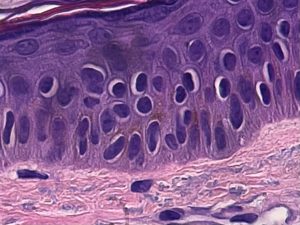Summer is “tanning season” for many who enjoy the look of darker skin. If you spend time soaking up the sun’s rays to achieve that sun-kissed glow, consider a safer alternative and get a spray tan instead. Read on to learn more about why sunless tanning is better for you than sun tanning.

Tanning is your body’s natural response to damage from ultraviolet (UV) radiation. “When your skin is exposed to UV radiation, it reacts by trying to protect the DNA in the nucleus. It does this by increasing the pigment melanin, which acts as a protective cap over the nucleus. So, increased exposure to UV radiation stimulates more production of this protective cap and resulting in the darkening of the skin, known as a tan,” says Pariser Dermatology Specialist Dr. Molly Smith.
Tanning beds escalate this biological process with artificial UV radiation, causing detrimental long term effects. According to the Skin Cancer Foundation, indoor tanning is connected to approximately 419,000 cases of skin cancer in the U.S. each year. As a result, sunless tanning products have been developed as safer alternatives since they lack the dangers associated with indoor tanning beds.
Risks of Tanning Beds
The organization IMPACT Melanoma reports that just 20 minutes of using a tanning bed is equal to 1 to 3 hours outside with no sun protection. This is due to the fact that tanning beds operate by generating an amount of radiation that is 3 to 6 times greater than the sun emits. This makes someone very susceptible to both melanoma and non-melanoma skin cancers, such as basal cell carcinoma and squamous cell carcinoma. Below are some statistics from the Skin Cancer Foundation linking indoor tanning to skin cancer:
- Using a tanning bed once before the age 35 increases an individual’s chance of developing melanoma by 75 percent.
- There is an increased risk of 83 percent for developing squamous cell carcinoma for individuals who use tanning beds.
- Using a tanning bed once before age 40 increases an individual chance of developing basal cell carcinoma by 69 percent.
These are just a few of the startling statistics associated with tanning beds and the development of skin cancer. According to the American Academy of Dermatology, tanning bed users can develop wrinkles, age spots and leathery skin much sooner than people who do not use tanning beds.
Wait, does this mean that tanning outside without sunscreen on is a safer alternative?
NO, it does not! “One is not better than the other. They both can negatively impact your health and cause DNA mutations that lead to skin cancer,” says Pariser Dermatology Specialist Dr. Molly Smith. In addition, the U.S. Food and Drug Administration reports that melanin produced from tanning only accounts for a Sun Protection Factor (SPF) of 2 to 4. This is much lower than the recommended SPF of 30 by the American Academy of Dermatology. So, how do you acquire your summer tan without increasing your risk of skin cancer? A sunless tan may be the answer you are looking for!
How Does Sunless Tanning Work?

Sunless tanning refers to self-tanner lotions, spray tans and other products that are directly applied to your skin in order to obtain your golden “glow”. A common ingredient, DHA, connects all of these sunless tanning products together.
Dihydroxyacetone (DHA) was discovered in the 1930s and has been used cosmetically since 1959. It is the active compound in self-tanners that is responsible for darkening your skin. Currently, DHA is the only sunless tanning chemical approved by the US Food and Drug Administration (FDA). DHA is a type of sugar that chemically reacts with the proteins in your stratum corneum, the first layer of your epidermis. This reaction results in the darkening of your skin without exposure to UV radiation.[1]
Since we are constantly shedding the outer layer of our skin, the effects of sunless tanners tend to last for a number of days. For longer lasting effects, visit the American Academy of Dermatology’s article on 8 essential steps for applying self-tanner here. How you apply your self-tanner or spray tan can make all the difference in how it looks and how long it lasts!
Are There Any Dangers Associated with Sunless Tanning?
There are few risks associated with sunless tanner lotions. The FDA recommends avoiding applying self-tanner products on certain areas, such as close to your eyes or inside of your mouth. These skin areas are more sensitive and can become irritated easily. However, if you choose to enter a spray tanning facility, the Mayo Clinic advises you to cover your eyes and to close your mouth to avoid ingesting the sunless tanner. Breathing in these chemicals can be harmful to your respiratory system.
Other questions have been raised about whether or not DHA is absorbed through your skin when applied. Yet, studies have shown that DHA is not absorbed into your body when applied topically since sunless tanners only stain the first layer of your epidermis.[2]
A common misconception is when people assume that a self-applied tanner will provide protection from the sun. Unless the product specifically states that it contains SPF, do not assume you are protected from the sun. Self-tanners usually have a low SPF of 2-3 as stated by the FDA. In fact, products containing 20% DHA in conjunction with sun exposure have been found to triple the chances of developing sun-induced wrinkles.[3] Although 20% DHA is usually a higher percentage than in over-the-counter sunless tanning products, it is still very important to either stay out of the sun or to diligently apply a sunscreen of SPF 30 or higher over your self-tanner.
Key Take-Aways
Tanning bed usage can drastically increase your risk of skin cancer. Sunless tanners, such as self- tanners and spray tans, are a safer solution than sun-bathing and are recommended by the American Academy of Dermatology, the Skin Cancer Foundation, and the American Medical Association as an alternative to sunbathing. Wearing daily sunscreen of at least SPF 30 is always recommended. If you think you might be at risk for skin cancer, call us at 757- 622 – 6315 to schedule a skin cancer screening today!
Additional References
- Ciriminna, Rosaria, et al. “Dihydroxyacetone: An Updated Insight into an Important Bioproduct.” ChemistryOpen, National Center for Biotechnology Information, 6 Mar. 2018, www.ncbi.nlm.nih.gov/pmc/articles/PMC5838383/.
- J. J. Yourick, M. L. Koenig, D. L. Yourick, R. L. Bronaugh, Toxicol. Appl. Pharmacol. 2004, 195, 309–320.
- J. Jung K;Seifert M;Herrling T;Fuchs. “UV-Generated Free Radicals (FR) in Skin: Their Prevention by Sunscreens and Their Induction by Self-Tanning Agents.” Spectrochimica Acta. Part A, Molecular and Biomolecular Spectroscopy, U.S. National Library of Medicine, Oct. 2007, pubmed.ncbi.nlm.nih.gov/18024196/.







